The Sherman Motors: Why So Many, And Why The Weird Ones?
The Sherman had four different motors that made it into production tanks. The R975 radial, The GM 6046 ‘twin’ diesel, the A57 multibank, and the Ford GAA V8. There was also a Caterpillar motor they were trying out I cover in the Shermans of the Future section.
There are several reasons the US went with the radial aircraft engine instead of a dedicated tank power plant, and this was mostly due to lack of money to develop tanks and their drivetrains between wars. When the US got serious about tank motors, there were a limited number of choices and the R975 was the best one. Then they turned to the US auto industry for other motor ideas, but only after the war was clearly looming. The US Government went to General Motors, and Chrysler, and asked for a tank motor ASAP, they got motors ASAP, but they were lash-ups, but they ultimately worked well. In this case, desperation produced the weird motors, and American automotive know-how, made them reliable.
GM came up with their twin bus motor, the 6046 and it was well-liked right from the beginning. Then Chrysler came out with the nutty but fantastic A57. The US Army didn’t like either and didn’t want to even use them for training. If the British hadn’t been willing to take the A57 versions, the Army would have regulated them to training use only. It wouldn’t be until Ford figured out the bugs in the GAA V8 that the US Army would make the switch from the R975. R975 powered M4s and M4A1s would serve with the US Army until the end of the war in just about every unit that used Shermans though, and they would not be phased out until after the war.
Post-war many A4 tanks would have R975s put in them, or in much rarer cases, the 6046. Parts of the A57 became rare post-war, and people who knew how to keep them working were probably rarer. I’m pretty sure almost all A4s used post the 50s were converted to one or the other of these motors. Conversions to the Ford GAA were not done as far as I can tell, I think because the US Army was stingy with this model and spares for it, so they could keep them for their own use or close allies.
The Continental R975 C1/C4: The Motor the Sherman was designed around
The Continental R975 C1/C4:
Type: 9 cylinder, 4 cycle, radial
Cooling system: Air Ignition: Magneto
Displacement: 973 CI Bore and stroke: 5×5.5 inches Compression Ratio: 5.7:1
Net Horsepower: C1/C4 350/400 hp Gross Horsepower: C1/C4 400/460 hp
Net Torque: C1/C4 800/ft-lb/940/ft-lb Gross Torque: C1/C4 890ft-lb/1025ft-lb
Weight: 1137 lbs dry Fuel: 80 Octane gasoline Engine Oil Capacity: 36 quarts
This motor was a license-built version of the Wright R-975 built by Continental for tank use. It had been around nearly ten years and used in civil aviation before the army started putting it in tanks, starting with the M2 medium in 1939, and would go on to produce more R-975s than Wright ever would, 53,000 motors total. The military version put out more horsepower than the civil version as well. This was a solid and reliable tank motor, but not ideal. It was a little underpowered and had to be revved up a lot to get the tank moving. The Army considered this a superior choice over the 6046 diesel and A57 motors, probably because it required a lot less maintenance than the other two motor choices. This motor would be swapped into M4A4 hulls by the French post-war, the French would use the A4, and A2 with the original motors during the war.
Another reason the motor was not ideal was the shape, the R975 is wide and tall, and this dictated how large the rear hull of the tank had to be. The only motor larger was the A57, and it was huge. There are still a lot of Shermans still running with this motor, either in civilian collections, or museums that keep running tanks.
The General Motors 6046: The Motor GM Came Up With To Power The Sherman
The General Motors 6046:
Type: 12 cylinder, 2-cycle, twin in-line diesel
Cooling system: Liquid Ignition: compression
Displacement: 850 ci Bore and stroke: 4.25×5 inches Compression Ratio: 16:1
Net Horsepower: 375 Gross Horsepower: 410
Net Torque: 1000 ft-lbs Gross Torque: 885-lb
Weight: 5110 lbs. dry Fuel: 40 cetane diesel oil Engine Oil Capacity: 28 quarts
First used in the M3A3 and M3A5 and then in the M4A2. This motor tied two GM supercharged truck diesel together on a common crankcase. The motors could be run independently, so if one was damaged the other could be used to get the tank back to a repair depot, or to keep fighting. The engine weighed more than the R975 but had better torque characteristics, and the tanks with this motor handled low-speed operation better because of the superior torque.
This version was ruled out for use by the Army because they didn’t want to complicate the tank supply chain by adding another fuel to it. This motor was well-liked by its users, and the only version of the Sherman the Soviet Union would take via lend-lease were the ones powered by this motor. The Army testing of this motor found it was as reliable as or more so than the R975.
This motor would run and drive the tank if one of the diesels failed. It has also been reported the Russians would use the ability to only run half the motor to sneak the tanks closer to German lines without being heard. They were impressed with how quiet the Shermans tracks were.
The early drawbacks to this motor were tied to its air cleaner system for the motors; they would clog quickly and required a lot of maintenance. Getting the two clutches for the motors synchronized was difficult on early tanks with these motors as well and this made for short clutch life. There were some other teething troubles with the fuel injectors and other problems, but these would all be solved early in the M4A2 productions, including improved injectors, air cleaners, and clutch system.
The US Army hadn’t wanted to use tanks with this motor in combat, but they ended up doing so since this motor also powered the M10.
The Chrysler A57 Multibank: The Motor Chrysler Came Up With To Power Tanks, It Was Crazy, And It Worked!
The Chrysler A57 multibank:
Type: 30–cylinder, 4-cycle, multibank
Cooling system: Liquid Ignition: Battery
Displacement: 1253 ci Bore and stroke: 4.37×4.5 inches Compression Ratio: 6.2:1
Net Horsepower: 370 Gross Horsepower: 425
Net Torque: 1020 ft-lbs Gross Torque: 1060 ft-lbs
Weight: 5400 lbs. dry Fuel: 80 octane gasoline Engine Oil Capacity: 32 quarts
This motor was a bit of an orphan in US Service. It powered the M3A4 and M4A4. The Army used the motor for training and tried to pawn a few off on the Marines. That lasted about two months at the Marine Tank School. The ever-growing need for tanks by the British ultimately solved what to do with the tanks that ended up with this motor. They would end up taking nearly 8000 of them. Chrysler sent tech reps to England with these tanks and showed the maintenance crews how to keep them running. This worked well and the engines served their purpose with little trouble. Often powering the best pure AT version of the Sherman, the Sherman VC Firefly. This motor saw a lot of use, during the war, and after with many countries being given Firefly Shermans to help out their recovering militaries. Some even ended up in South America, but I’m not sure what versions. This is my favorite Sherman motor because it’s so absurdly complicated, it’s almost German, but it actually worked, so not German at all.
This motor was fairly robust and would continue to run and allow the tank to move with three of the five-cylinder banks not working. This would make the tank severely underpowered but would be useful to get it back to the repair yard or onto a dragon wagon. I’m sure it was much more common to have one of the five not operating right, and that level of power loss would be an annoyance, but wouldn’t keep the tank from fighting if it was really needed.
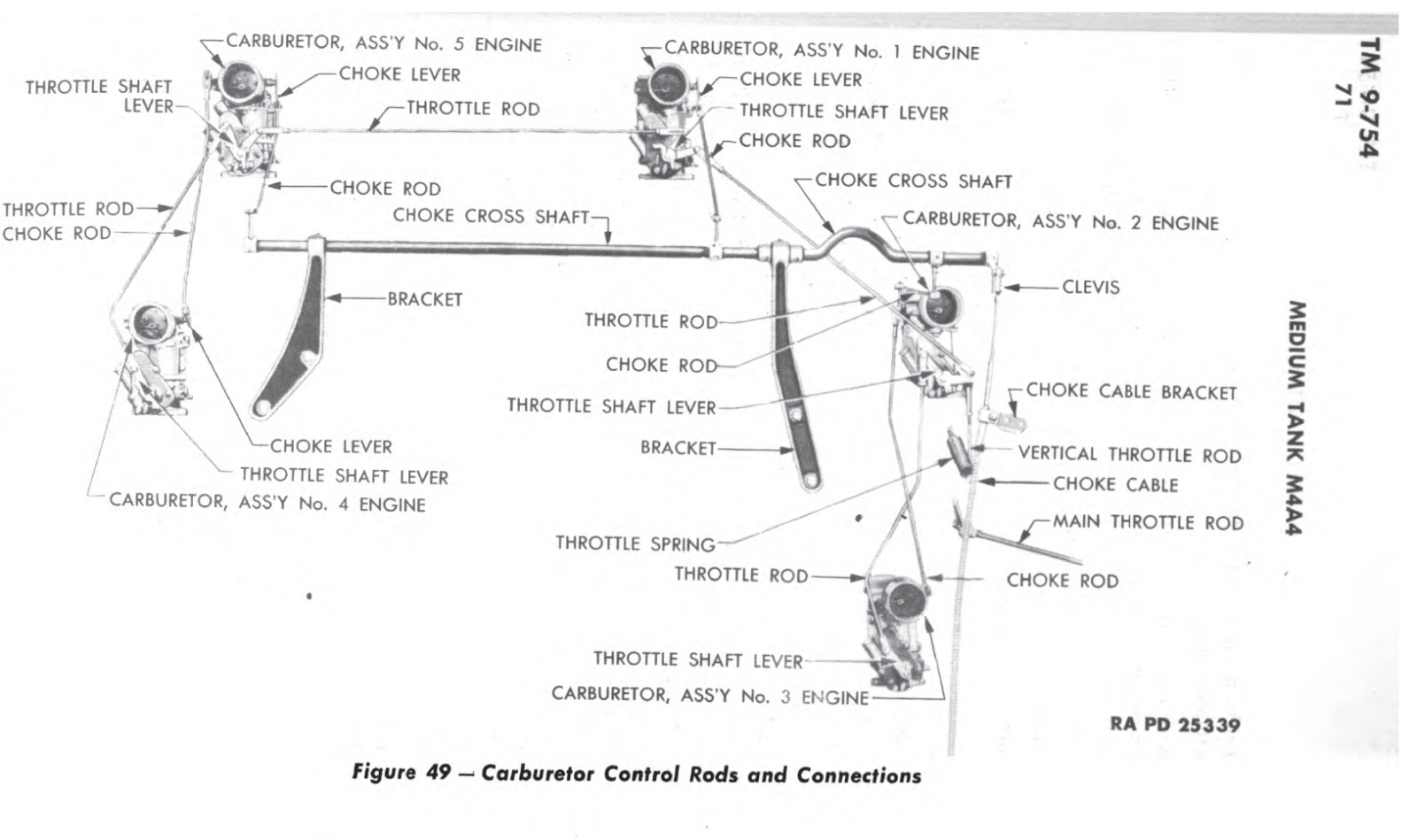
During the war, Chrysler really went to bat to keep these motors working well. Since it was based on a motor already long in production, spare parts were readily available. I’m not sure how long support for the motor lasted after the war. I doubt it was very long, and American car parts were probably not easy to acquire to keep these motors running. Because of this, the M4A4, more than any other model seems to have its engine replaced in post-war service. I’ve read about the twin diesel and the R975 being swapped in. There are a few M4A4s around in Europe with running A57 motors, both fireflies if I recall right. You have to love anyone willing to keep one of these motors running.
Daily maintenance could be done with the motor in the tank, carburetor and timing adjustments, fluids and filters, and things like that. If anything major needed to be fixed, one of the motors had a bad piston or valve, or even something minor like a big vacuum leak on the intake of one of the motors, or even a leak in the cooling system, the whole motor would have to be pulled. Chrysler knew this and made getting the motor in and out as easy as possible, including huge lifting eyes built on the common block to help lift the motor out. The British probably had several depots set up to rebuild A57 power packs that were in need of major work, and Chrysler made a lot of spare motors and parts to support the motor.
To be fair, many serious problems with the other tank motors would require pulling the motor to fix them as well.
The Ford Motor Company GAA V8: The Best Sherman Motor
The Ford GAA:
Type: 8 cylinders, 4-cycle, 60-degree V8
Cooling system: Liquid Ignition: Magneto
Displacement: 1100 ci Bore and stroke: 5.4 x 6 inches Compression Ratio: 7.5:1
Net Horsepower: 450 Gross Horsepower: 500
Net Torque: 950 ft-lbs Gross Torque: 1040 ft-lbs
Weight: 1560 lbs. dry Fuel: 80 octane gasoline Engine Oil Capacity: 32 quarts
The Ford GAA only made it into one Lee as a testbed. But it powered a lot of Shermans, both large and small hatch. It would go on to be the motor of choice for the US Army for the rest of the war, and in the next tank, the M26. Just look at the numbers above and compare them to the rest of the motors. The GAA is really a much better motor for a tank in the Shermans weight range. This tank was not lend-leased to the other allies in large numbers if at all. The USSR may have gotten one to evaluate, the UK too, but the Army wanted to switch over to this and stop using R975 powered tanks. After the war, the only Shermans they kept were M4A3 76 w tanks, and over time they converted as many of these to HVSS suspension as possible. They went as far as swapping T23 turrets from M4A1 76 W tanks onto M4A3 75 hulls. The army would produce several other gas-powered tank engines, but none would really shine like this one did in the Sherman.
The motor started life as a V12 Ford had designed to compete with the Rolls Royce Merlin, after a deal to produce the RR engine fell through. Ford was incensed that a deal could not be worked out and decided to build his own V12 aircraft motor. When he tried to sell it to the Army he was turned down, but later when the army needed tank motors he used the V12 as a basis for the V8, by removing 4 cylinders. As a tank motor, it was under very low stress putting out only 500 horsepower, and could have been really upped in horsepower with a few tweaks.
This motor does not get much credit for how advanced it was. The much talked about, and unreliable as hell, German Maybach HL 230 P30, the motor used to power the Tigers, and Panther tanks, was not nearly as advanced, or as reliable as this amazing V8. This V8 is apparently the largest gas-powered all-aluminum V8 ever produced. It has some very advanced features, even for a modern V8, like a one-piece cast aluminum block with dual overhead cams and four valves per cylinder a true, dual, overhead, cam, motor, or DOHC. It had a very innovative 8-way power drive system for its accessories, like the generators, fuel and water pumps, and two magnetos. The motor used no belts or chains, everything was gear and shaft driven.
This motor saw post-war use in civilian hands, from powering logging equipment, to use as stationary pump motors. The most interesting post-war use is in pro-tractor pulling and hotrod use. These installations in most cases just update the intake and exhaust using modern carbs, but in one crazy case down in Brazil they have updated a GAA with coil and spark plug and crank sensor` computerized ignition, fuel injection and twin turbos, and just 8 pounds of boost it makes 1500 hp, with a higher boost number the engine is capable of 3000 HP. For more info on these modifications and some pics, check out this link.
GAA Data Sheet
Sources: Sherman by Hunnicutt, The Sherman Minutia Site, Son of a Sherman by Stansell and Laughlin, M4 Sherman tank at war by Green, Tanks are a Might Fine Thing by Stout, TM9-731B M4A2, TM9-731G M10A1, TM9-745 GMC M36B2, TM9-748 GMC M36B1, TM9-750M3, TM9-752 M4A3, TM9-754 M4A4, TM9-759 M4A3, TM9-1725 R975 C4, TM9-1731B Ford motors(GAA, GAF, GAN), TM9-1750F A57 Multibank

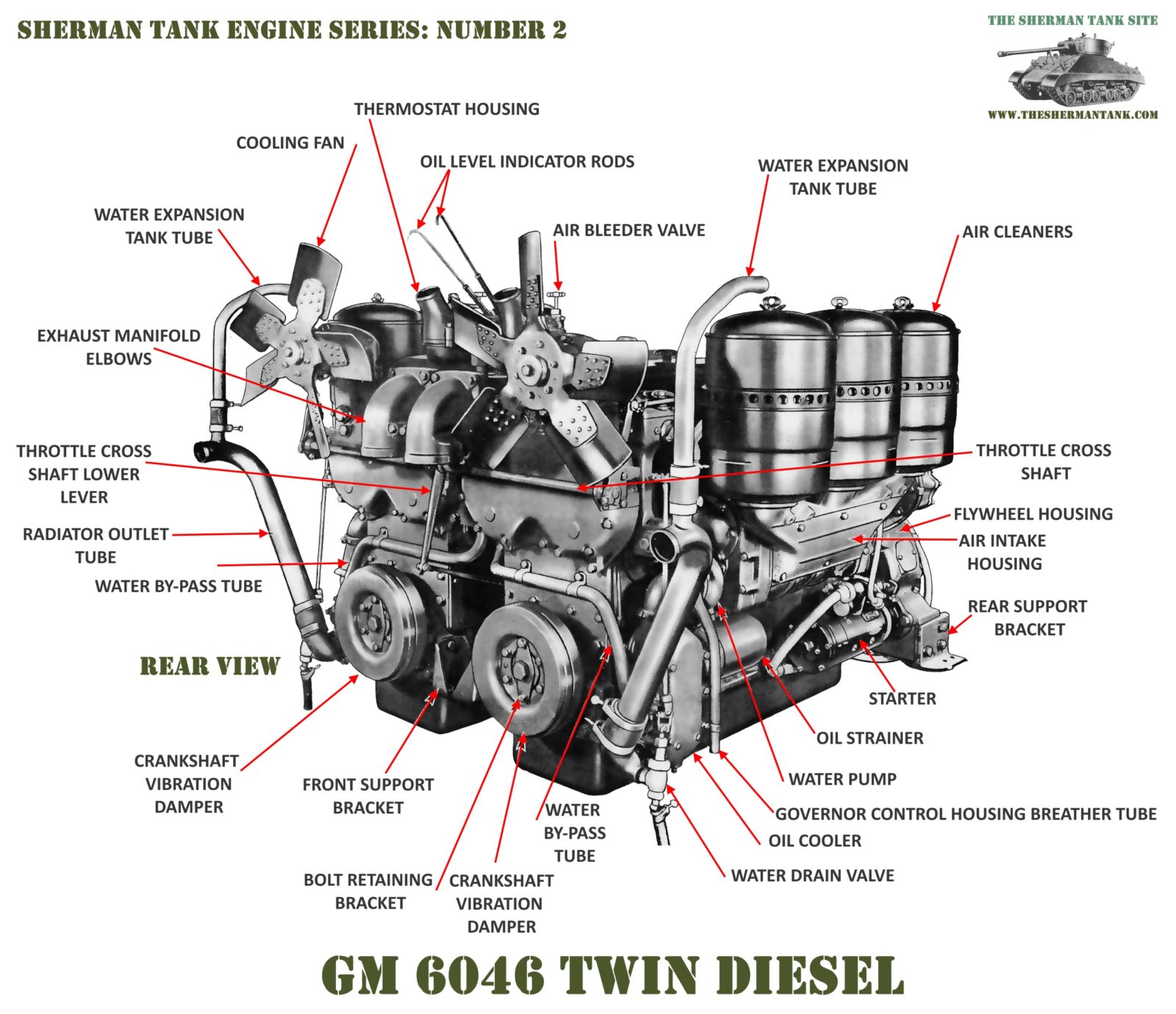









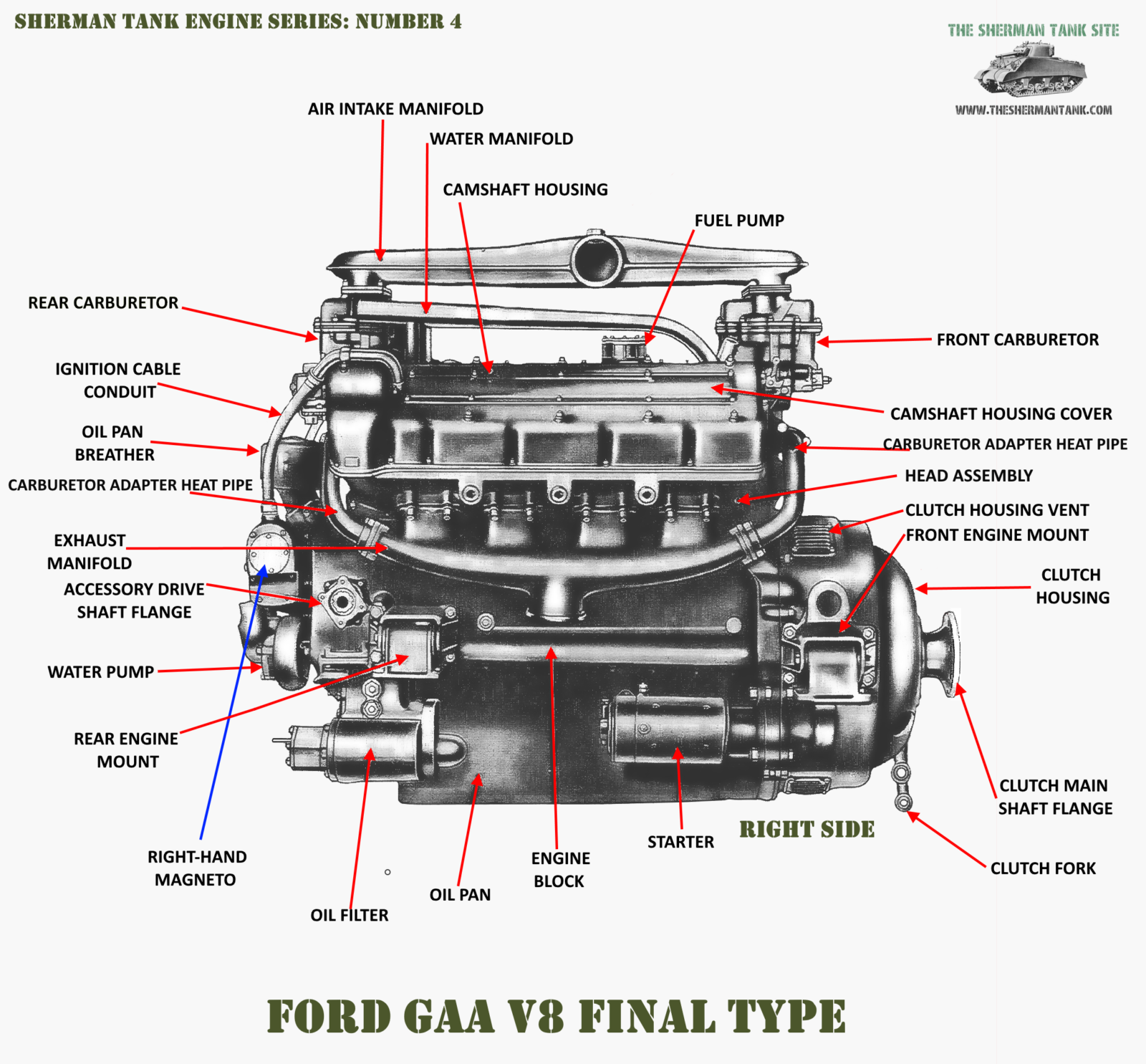
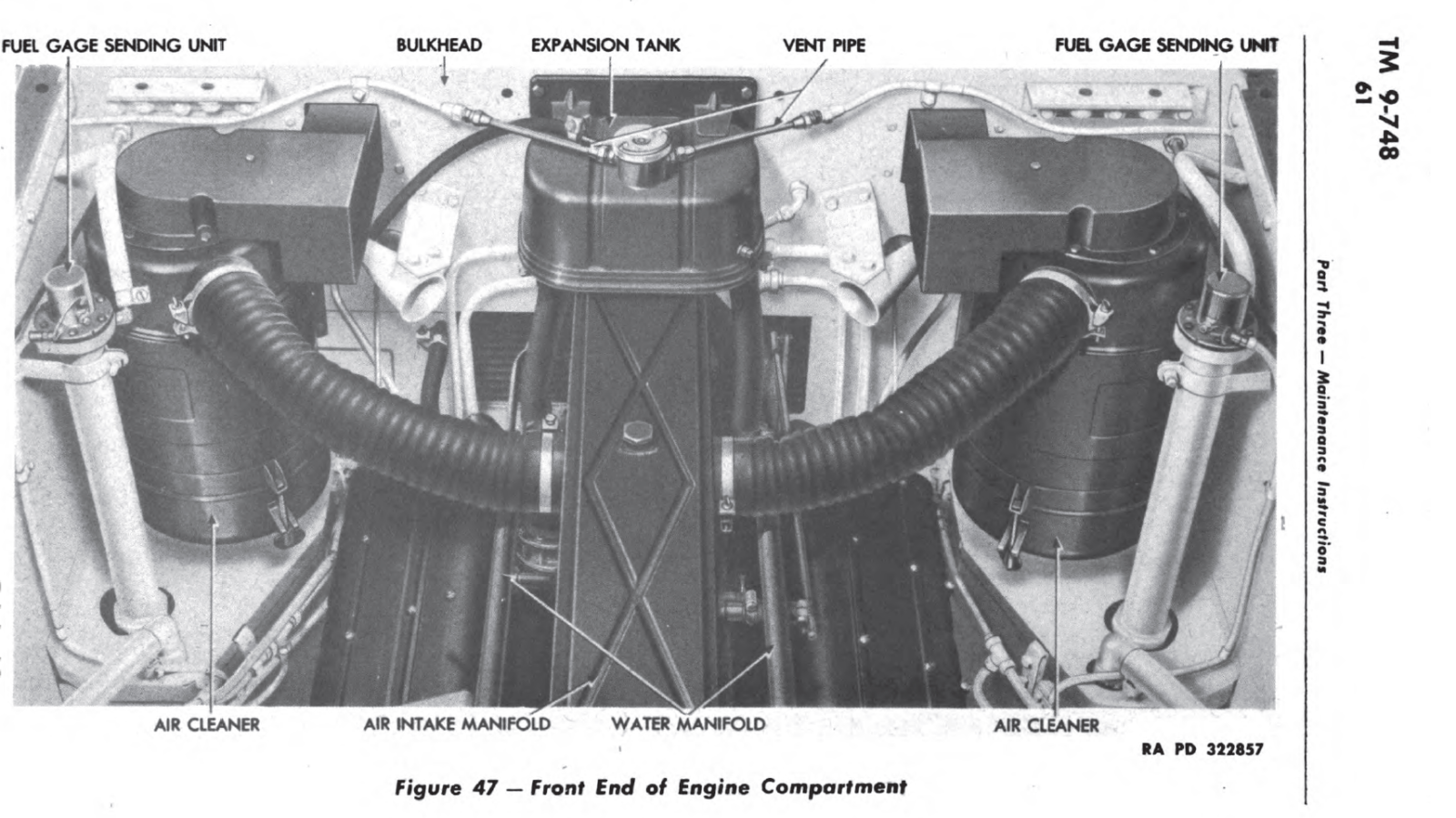
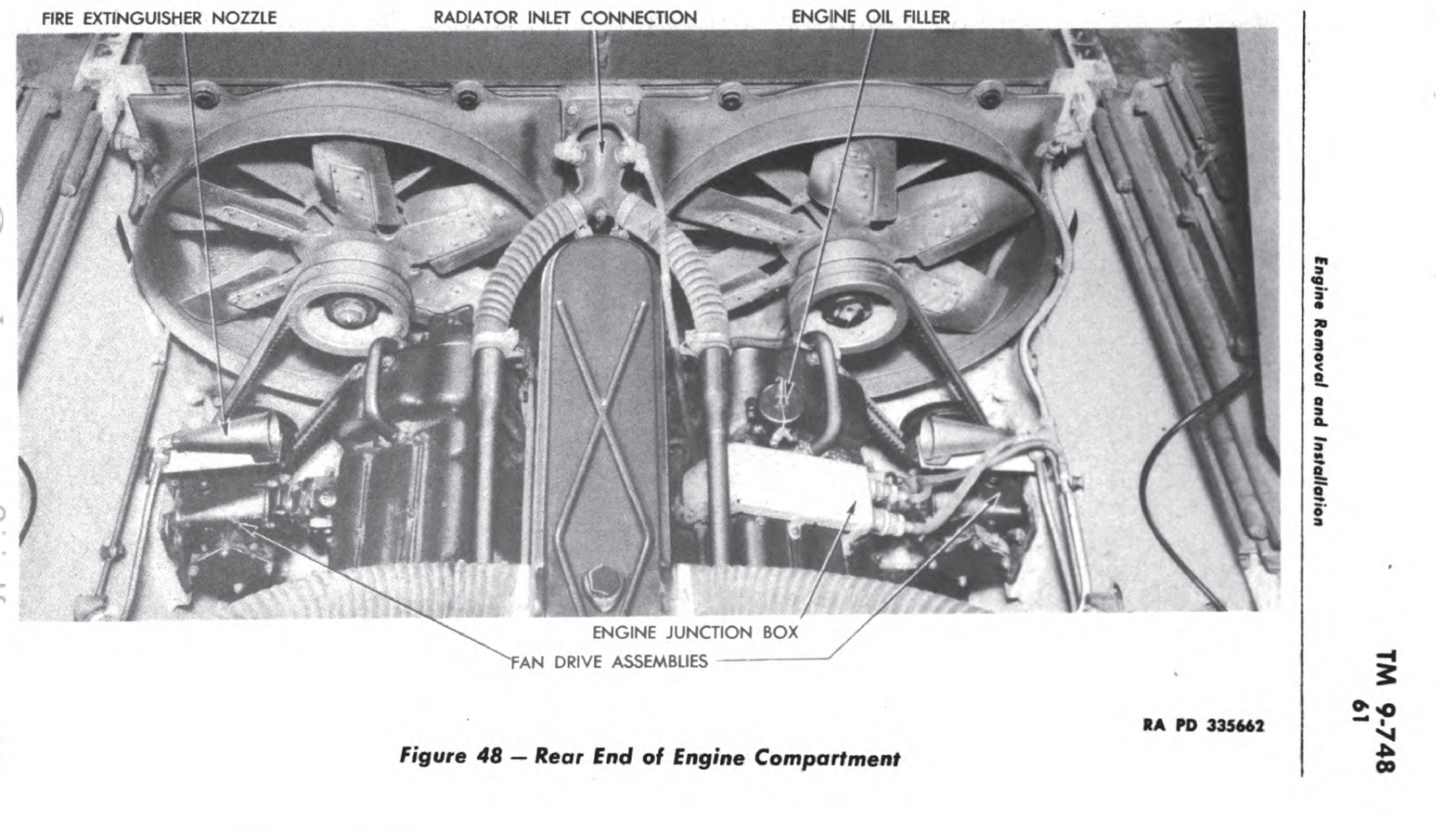


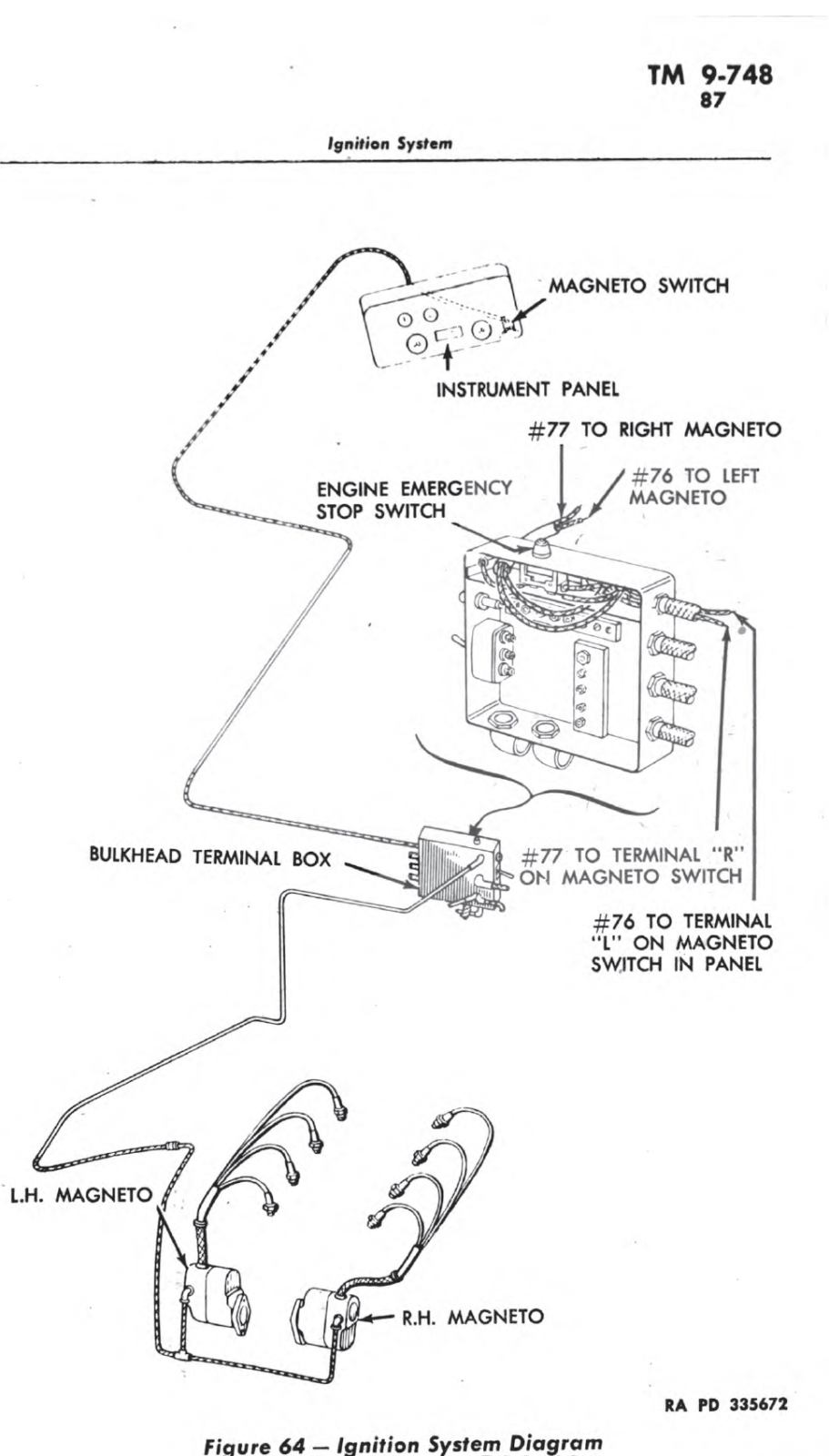
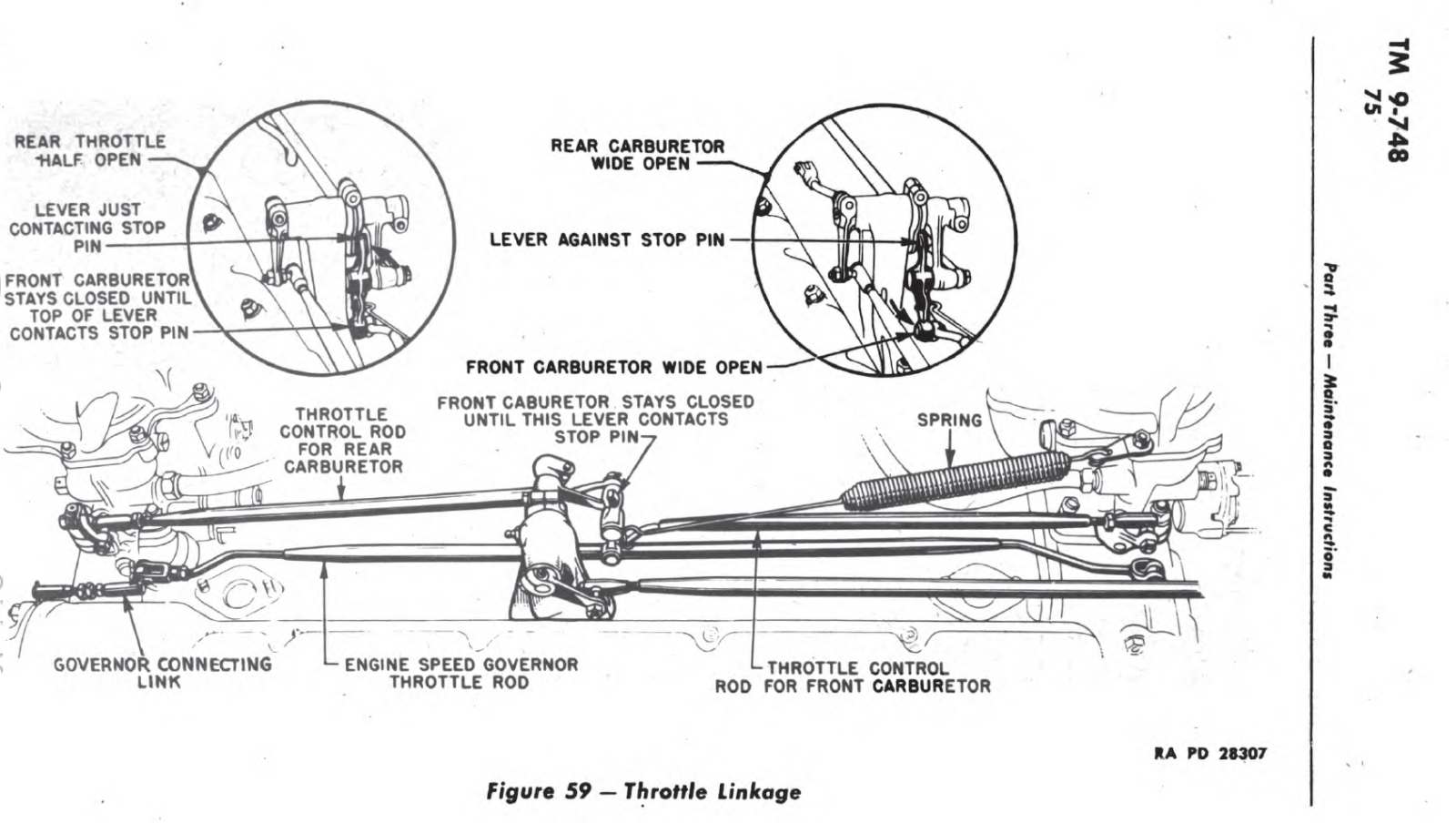

In 1979 in Kitzengen Germany 1/64 armor pulled a radial engine powered Sherman off a display and got it running for a celebration. Once battalion maintenance got it running, it ran very well. To get the engine running, battalion maintenance pulled the engine and suspended it from a hoist. Whenever Chief Matthews tried an engine start, a small crowd would gather. After restoring it to running status it was reinstalled. Someone said the tank ran “like a scalded dog”. LOL. The track was all steel and slightly damaged some of the streets on the Kasserne. I remember it passing me going fast. 1/64 was equipped with M60A2’s and M60A1’s at the time.
Great Story. I wonder what model Sherman it was and what engine it had.
As far as the A57 multibank goes the 251 was commercially available until the late 70s . The A57 specific parts might of been scarce but I’m sure Chrysler stockpiled a lot. The 251 six was used in British Commer (Rootes group) trucks in the 50s and early 60s until Chrysler bought 100% of the company in 1967. Until 1967 Chrysler held minority ownership in Rootes . So the 251 six cylinder was known to the British postwar and parts were available to them. I also believe the 251 was eventually installed in the civilian/quasi military WM-300 “Power Wagon” (military M-601 MDAP).
Was there ever a Ford ‘Power Pack’ engine? I believe I saw a photo of one consisting of two straight 8 cylinder Lincoln car engines mated side-by-side to a common transmission and was fueled with high octane aviation gas.
Mike,
Not used in a Sherman or any Tank I know of, but there have been a lot of AFV motors in prototypes over the years so I am no authority.
[IMG – https://vk.targethunter.ru/rtrg/246980-hheIK.gif%5B/IMG – РАСПРОДАЖА БРЕНДОВЫХ ЧАСОВ. СКИДКА ДО 50% НА ВЕСЬ КАТАЛОГ! НАЖМИТЕ НА ССЫЛКУ, ЧТОБЫ УЗНАТЬ О НИХ ПОДРОБНЕЕ http://bit.ly/2H01Jk8
купить часы интернет магазин часов
Скидка до 50%
Hi again.
“The American Arsenal: The World War II Official Standard Ordnance Catalogue”
I found some engine specs in this book, via Google books, which also mentions the Guiberson 1400. Not many were built apparently. It gives specs for M4 engines and fills in some some missing data such as engine dimensions including the R975 in conveniently tabulated form. You can view the tables by searching for ‘Medium and heavy tank engines’ without quotes, which will take you to the chapter. Click and holding will allow you to pull the pages up and down. One table is on page 37 and a second on page 38
Here’s the link which may take you straight to the chapter.
https://books.google.co.uk/books?id=NeYDDQAAQBAJ&pg=PA38&lpg=PA38&dq=guiberson+t-1400+radial+tank+engine+data&source=bl&ots=jKLdisOmsS&sig=70uvfX4dkkOk0Qd8251U3WFA2yE&hl=en&sa=X&ved=0ahUKEwiv5f3XvprTAhVrBcAKHRSZB0EQ6AEIKTAC#v=onepage&q=mediam%20and%20heavy%20tank%20engines&f=false
Steve
That’s a great find, I want a copy of that book for my shelves!
If I find any information on any of the motors I’ll post it here. You’ve done a lot of careful research and produced a good sight.
All the best.
May I commend you on this truly excellent site.
If I may I offer a humble suggestion, an added bonus would be the overall dimensions of each engine, in addition to the data already given. This isn’t as easy as it seems as not even the technical manuals provide these details. I believe only the crankshaft length is provided in TM9-1750G for the GM twin diesel used in the M4A2, for example. I have found this to be a problem with British tank engines in particular and also with turret ring sizes. Authors are keen to use words like ‘bigger’ and ‘wider’ without actually quoting the specific sizes.
The sizes of turret rings and engines are two crucial specifications determining the capabilities of a particular tank. What made the Sherman so versatile were its comparatively large turret ring of 69″ and its large engine compartment, that never seems to be stated.
This is a fabulous site, well done.
Steve, I did include that data on the Ford GAA data booklet, and it will be in the booklets on the GM 6046, and A57, but so far, I can not find the dimensions on the R975, of course this motor is the one I have the least good data on. Im working on the 6046 data book as we post this, the it’s L64 5/32, W 59 3/4 and H 49 1/32 that’s all in inches.
Check out the GAA Data book here,
Thanks for that. I don’t know how I missed it 🙁
TM9-1751 (on archive.org)
9-Cylinder,
Radial, Gasoline Engine
(Continental Model R975-C1)
Size of engine crated. ………. Length 55.75 in., width 53.50 in.,
height 51.875 in.
Thanks for your help. I’ll keep checking your updates.
Steve!
I’ve had the manual for some time, I must just be going blind or something! Good find and thanks!
Thing is, I don’t know if that’s the size of the crate though. Ha ha.
The aero-engine has a length of 43 inches and a diameter of 45 inches, considerably less than the dimensions given in the TM-9 manual for the tank motor. This is the specification in numerous aeroplane publications.
Most radials have their diameter given, as with the Caterpillar D-200 (RD-1820) at 55 inches, shown in the TM_9-1756A.
For some reason the manuals do not have the same layouts, so you may understand my confusion.
Steve,
I have had the same problems with confusion over the Shermans manuals as well. In general it seems the earlier manuals had much less info, and some the later manuals do not have like stuff on chemical weapons protections. The later manuals are very informative, but I do not have good quality ones for the M4 and M4A1, and all the overhaul manuals I have on all the motors are all pretty bad as well.
The R975 is going to be the least informative data book I’m going to do just because I lack any good schematics or technical drawings, cause the ones in the manuals are photocopy bad.
The only place I can find 9-731AA Medium Tank M4 and Medium Tank M4A1(76-mm Gun) is a French site, I think, and I’m not sure if they are offering a PDF or an actual reprint! lol.
Yeah, crate size had me wondering as well, I’ve seen several forms of crating and its all pretty tight, but I’m sure adds several inches to all dimensions.
Well, thanks for the input Steve!
In 1964 I recall that my maint. unit salvaged a M4A1E3 tank at Graf…..r, Germany that was destined to be a training target on the tank range. We serviced it and it ran like new. I drove in a parade or two. Wonderful piece of equip..
The weirdest engine I’ve ever seen it’s a opposed-piston engine in some USSR tank. In that engine each cylinder has two pistons.
Google the Commer TS-3 . A 2 cycle 3 cylinder British truck engine
Or the Napier Deltic engine used in the British Railways English Electric built diesel railway loco of the same name and also the Royal Navy’s Motor Torpedo boats. An engine with three crankshafts in a triangular configuration with three sets of cylinders, each having opposing pistons inside from two of the crankshafts.
https://everythingaboutboats.org/napier-deltic/
Dear Sir……. i want to use the images of the Sherman engines in a book that i am writing on the history of the Pakistan Armoured Corps. the book will be sold commercially with print run of under 2000 and the images will be printed on 1/4 page. i am willing to pay the cost of the image and licence to print if you have the copy rights to these images
What images exactly? If I don’t own them, I’ll try and put you in touch with who does.